2014年03月24日
Thatching in Shikokumura
Spring is here at last! Today, I dropped into Shikokumura to truly enjoy it.
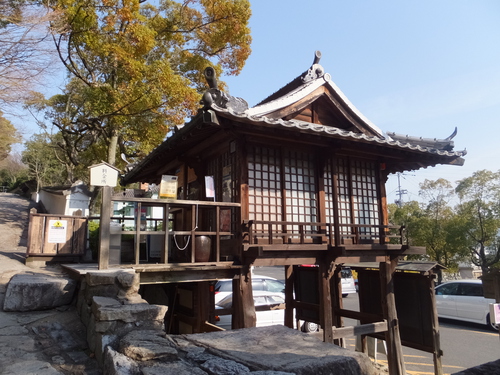
Shikokumura entrance
Perched on the slope of Mount Yashima, this outdoor historical museum presents not only exquisite examples of traditional building styles
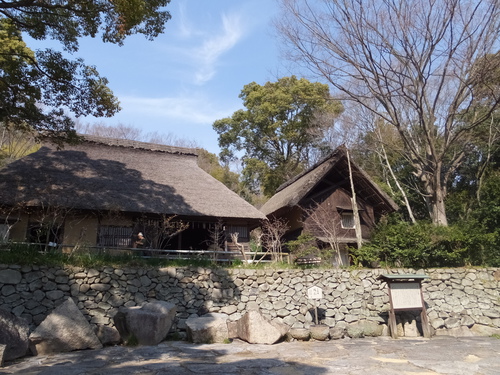
but also a profusion of botanical specimens.
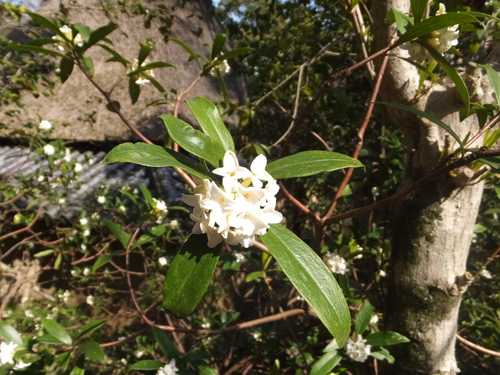

Both flora and architecture can be appreciated while hiking along artfully arranged paths of stone and old railway ties that are edged with moss, bamboo, streams and waterfalls.

When I dropped into the museum today, I had the added treat of seeing thatchers at work because the sugar press huts are being re-thatched.
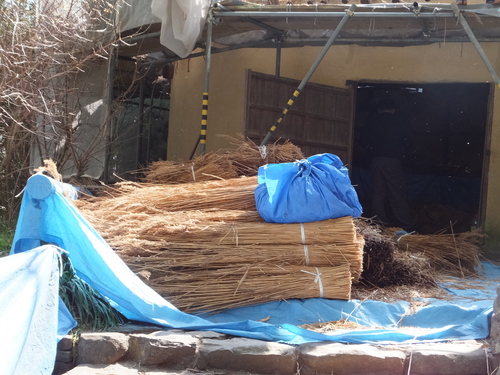

Much like barn-raising in rural Canada where I hail from, thatching was once a community activity involving the whole village. In Shikoku, however, the art has almost died out. Many traditionally shaped peaked roofs that obviously used to be thatched are now covered in metal instead.
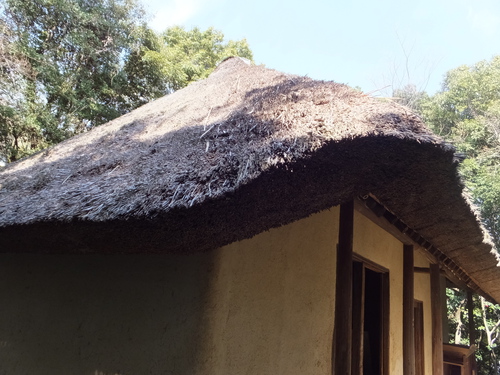
It’s a shame really as thatch seems far more ecological than most building materials in use today. Unlike tiled roofs, the materials were readily at hand, growing in wetlands and purifying the water, and compared to the thick clay tiles used in Japan, thatching is still within the realm of “do-it-yourself” technology.
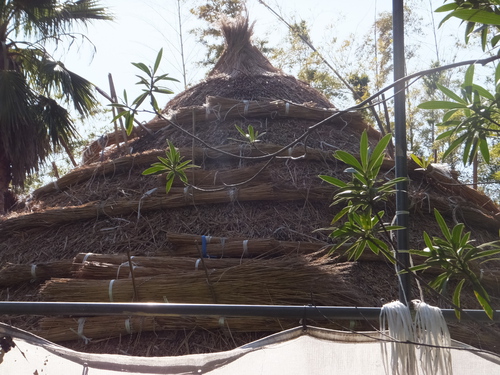
The heavy thatched roofs made for a very cool interior during the hot humid summers of Japan and for a warm interior in winter.

Now, however, materials are scarce as most wetlands have been filled in and built over, the demand for thatching is low, and few people remember how to thatch. Modernization, coupled with the fact that thatch is more vulnerable to fire than tiles contributed to the decline of this roofing technique. Considering the state of the environment, perhaps we should consider reviving this renewable approach to architecture.

If you can visit soon, you should be able to see the work in progress. And if you go before March 31, you can also catch the hina-matsuri dolls exhibited in various buildings on site.
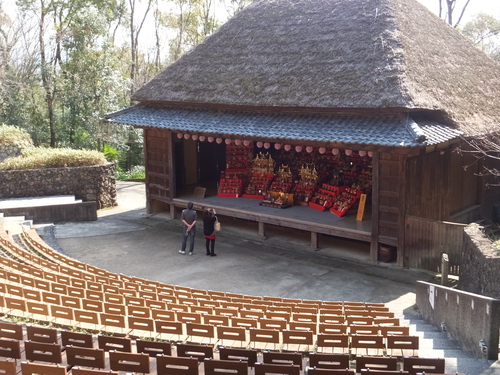
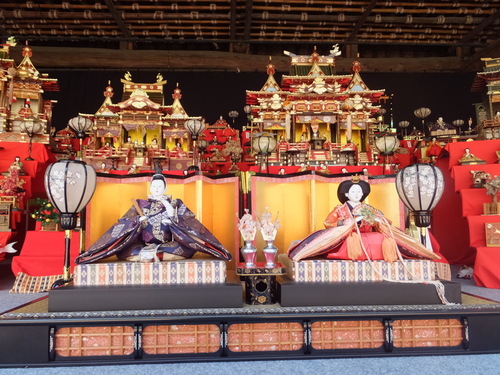
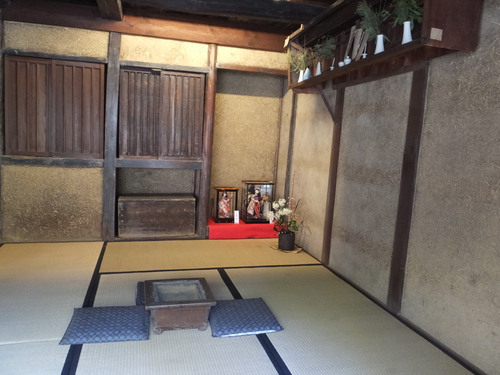
For details, see http://www.yashima-artvillage.jp/english/museum/shikokumura.html
For more info on Takamatsu:
http://wikitravel.org/en/Takamatsu
http://www.city.takamatsu.kagawa.jp/english/
http://tia-takamatsu.jp/
http://www.my-kagawa.jp/eg/
Other Takamatsu bloggers:
http://pat.ashita-sanuki.jp/
http://ogijima.com

Shikokumura entrance
Perched on the slope of Mount Yashima, this outdoor historical museum presents not only exquisite examples of traditional building styles

but also a profusion of botanical specimens.


Both flora and architecture can be appreciated while hiking along artfully arranged paths of stone and old railway ties that are edged with moss, bamboo, streams and waterfalls.

When I dropped into the museum today, I had the added treat of seeing thatchers at work because the sugar press huts are being re-thatched.


Much like barn-raising in rural Canada where I hail from, thatching was once a community activity involving the whole village. In Shikoku, however, the art has almost died out. Many traditionally shaped peaked roofs that obviously used to be thatched are now covered in metal instead.

It’s a shame really as thatch seems far more ecological than most building materials in use today. Unlike tiled roofs, the materials were readily at hand, growing in wetlands and purifying the water, and compared to the thick clay tiles used in Japan, thatching is still within the realm of “do-it-yourself” technology.

The heavy thatched roofs made for a very cool interior during the hot humid summers of Japan and for a warm interior in winter.

Now, however, materials are scarce as most wetlands have been filled in and built over, the demand for thatching is low, and few people remember how to thatch. Modernization, coupled with the fact that thatch is more vulnerable to fire than tiles contributed to the decline of this roofing technique. Considering the state of the environment, perhaps we should consider reviving this renewable approach to architecture.

If you can visit soon, you should be able to see the work in progress. And if you go before March 31, you can also catch the hina-matsuri dolls exhibited in various buildings on site.



For details, see http://www.yashima-artvillage.jp/english/museum/shikokumura.html
For more info on Takamatsu:
http://wikitravel.org/en/Takamatsu
http://www.city.takamatsu.kagawa.jp/english/
http://tia-takamatsu.jp/
http://www.my-kagawa.jp/eg/
Other Takamatsu bloggers:
http://pat.ashita-sanuki.jp/
http://ogijima.com
My Profile
Cathy Hirano キャシー ヒラノ
I've lived in Japan since 1978. After graduating from a Japanese university with a BA in cultural anthropology in 1983, I worked as a translator in a Japanese consulting engineering firm in Tokyo for several years. My Japanese husband and I moved to Takamatsu in 1987 to raise our two children in a slower-paced environment away from the big city pressures. We've never regretted it. I work as a freelance translator and interpreter and am involved in a lot of community work, including volunteering for Second Hand, a local NGO that supports educational and vocational training initiatives in Cambodia, and for the Takamatsu International Association. I love living in Takamatsu.
Cathy Hirano キャシー ヒラノ
I've lived in Japan since 1978. After graduating from a Japanese university with a BA in cultural anthropology in 1983, I worked as a translator in a Japanese consulting engineering firm in Tokyo for several years. My Japanese husband and I moved to Takamatsu in 1987 to raise our two children in a slower-paced environment away from the big city pressures. We've never regretted it. I work as a freelance translator and interpreter and am involved in a lot of community work, including volunteering for Second Hand, a local NGO that supports educational and vocational training initiatives in Cambodia, and for the Takamatsu International Association. I love living in Takamatsu.
Posted by cathy at 23:12│Comments(0)
※会員のみコメントを受け付けております、ログインが必要です。





